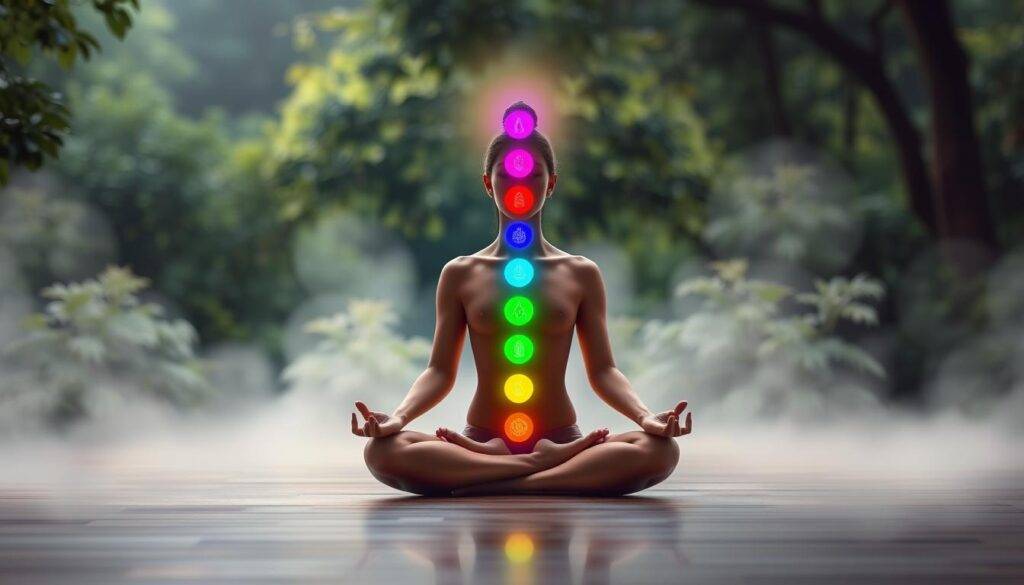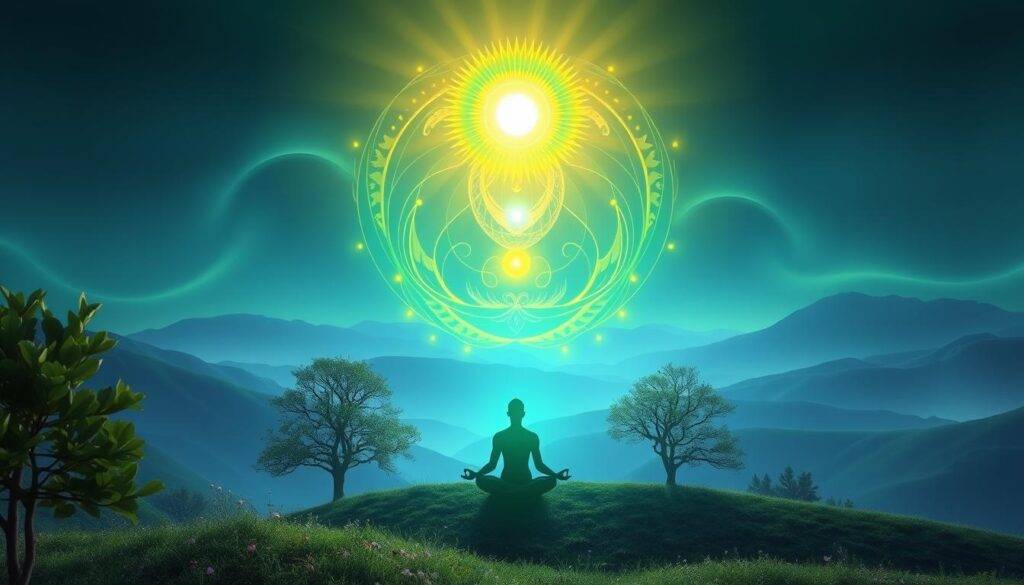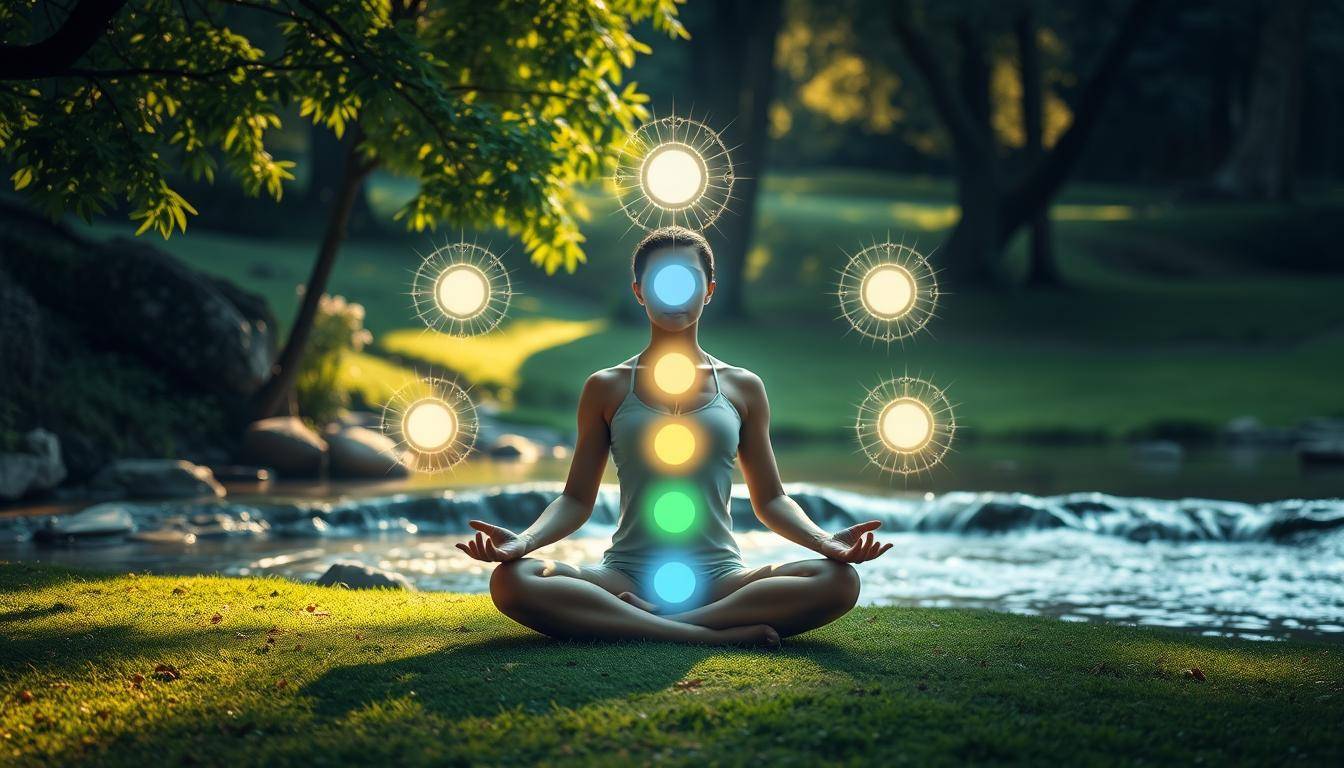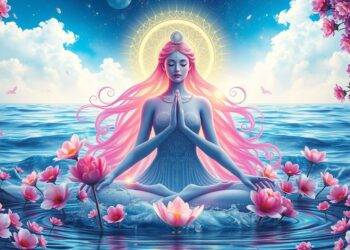“The chakras are the energy centers of the body, and when they are in balance, we experience a sense of wholeness and well-being.” – Deepak Chopra, renowned author and wellness expert.
Start your journey to inner power with chakra meditation. This ancient practice helps you feel grounded and at peace. It connects you to your mindfulness practice and leads to a deep spiritual awakening.
Chakra meditation is easy yet powerful. It boosts your self-care, lowers stress, and brings positivity. This guide is perfect for beginners and seasoned practitioners alike. It will help you on your path to chakra balancing and better well-being.
Key Takeaways
- Chakra meditation is an ancient wellness practice that unlocks energy centers in the body
- It helps individuals feel grounded, centered, connected, and peaceful
- Exploring the seven chakras can enhance self-care, reduce stress, and promote positivity
- Chakras correspond to different colors, functions, and physical/mental health aspects
- Guidance from qualified teachers can help navigate energy flow and imbalances effectively
Understanding the Ancient Practice of Chakra Meditation
Chakra meditation comes from ancient Indian yogic traditions, dating back to 1500-1200 BCE. The word “chakra” means “circle,” “disc,” or “wheel” in Sanskrit. This practice focuses on the seven major energy centers in the body. Each center affects different glands and qualities.
Origins and Historical Significance
Chakra meditation is rooted in ancient Indian yogic texts. These texts describe energy centers along the spine. They believed these centers, or chakras, were key to physical, emotional, and spiritual health.
The goal of chakra meditation was to balance these centers. This brought the body into harmony.
The Meaning Behind Chakras
The seven main chakras are linked to body parts, emotions, and qualities. For instance, the root chakra is at the spine’s base and deals with basic needs and security. The sacral chakra, below the navel, is about creativity and emotions.
Each chakra has a unique frequency and color. When balanced, they help promote inner peace and stress relief.
Modern Applications in Wellness
Today, chakra meditation is popular for yoga for beginners and holistic wellness. It helps align and cleanse the chakras. This can lead to less stress, better focus, and more self-awareness.
Chakra meditations are often paired with energy healing and crystal therapy. This combination supports overall well-being.
“Chakra meditation is a powerful tool for self-discovery and personal growth. By tuning into the subtle energy centers within the body, we can unlock our true potential and find greater harmony in our lives.”
The Seven Major Chakras and Their Meanings
The chakra system is ancient, dating back to 1500 to 500 BC. It has seven major chakras in our body. Each chakra is linked to colors, locations, and aspects of our health. Knowing these chakras is key for chakra balancing, spiritual awakening, and holistic wellness.
- Root Chakra (Muladhara): At the base of the spine, it develops in the first 1-7 years. It deals with safety, security, and belonging.
- Sacral Chakra (Svadhisthana): In the pelvic area, it grows from 8-14 years old. It’s about creativity, emotions, and sexuality.
- Solar Plexus Chakra (Manipura): In the stomach, it emerges between 15-21 years old. It’s about personal power, self-esteem, and decision-making.
- Heart Chakra (Anahata): In the chest, it develops from 21-28 years old. It’s the center of love, compassion, and connection.
- Throat Chakra (Vishuddha): In the throat, it opens up from 29-35 years old. It’s about communication, self-expression, and authenticity.
- Third Eye Chakra (Ajna): Between the eyebrows, it blossoms from 36-42 years old. It’s linked to intuition, visualization, and spiritual awareness.
- Crown Chakra (Sahasrara): At the top of the head, it develops from 43-49 years old. It represents connection to the divine, enlightenment, and unity.
In today’s world, finding balanced chakras is rare. Chakra blockages can cause physical, emotional, and spiritual issues. By understanding each chakra, you can focus on chakra balancing and start a journey of spiritual awakening and holistic wellness.
“Chakras are like knots resulting from resistance, referred to as ‘nots.'” – Anodea Judith
| Chakra | Development Stage | Location | Associated Aspects |
|---|---|---|---|
| Root Chakra | 1-7 years old | Base of spine | Safety, security, belonging |
| Sacral Chakra | 8-14 years old | Pelvic region | Creativity, emotions, sexuality |
| Solar Plexus Chakra | 15-21 years old | Stomach area | Personal power, self-esteem, decision-making |
| Heart Chakra | 21-28 years old | Chest area | Love, compassion, connection |
| Throat Chakra | 29-35 years old | Middle of throat | Communication, self-expression, authenticity |
| Third Eye Chakra | 36-42 years old | Between eyebrows | Intuition, visualization, spiritual awareness |
| Crown Chakra | 43-49 years old | Top of head | Connection to the divine, enlightenment, unity |
Essential Preparations for Chakra Meditation for Beginners
To start a chakra meditation, you need the right setting. Find a quiet, comfy spot with no distractions. Wear loose clothes that let you move easily. Use cushions or bolsters to support your body and keep you comfortable.
Creating the Perfect Meditation Space
Getting the mood right is key for chakra meditation. Dim the lights or light candles for a calm feel. Soft music or nature sounds can help you relax. Make sure your devices are off to avoid interruptions.
Recommended Props and Tools
- Meditation cushion or yoga mat
- Bolster or pillow for back support
- Crystals or gemstones associated with specific chakras
- Essential oils or incense to enhance the experience
- A guided meditation recording or a step-by-step guide for beginners
Setting the Right Mood
To get ready for guided meditation or mindfulness practice, think about your senses. Dim the lights, light candles, and play calming music. Use objects that mean something to you, like crystals or figurines. Take deep breaths and settle into the moment.
“Chakra meditation is a powerful tool for aligning your energy centers and unlocking your inner potential. With the right preparations, you can create a transformative experience that nourishes your mind, body, and spirit.”
Step-by-Step Guide to Basic Chakra Meditation
Start your journey into chakra meditation for beginners and discover your energy centers’ power. This guide will show you the basics of this powerful mindfulness practice.
Find a quiet, comfy spot to sit or lie down. Close your eyes and breathe deeply. Feel your body relax and your mind calm.
- Imagine the root chakra at your spine’s base. See a glowing red circle, filled with grounding energy.
- Think of the sacral chakra below your navel. Picture a vibrant orange sphere, linked to creativity and feelings.
- Focus on the solar plexus chakra in your abdomen. See a bright yellow orb, symbolizing personal strength and confidence.
- Look at the heart chakra in your chest. Picture a calm green circle, showing love and kindness.
- Think of the throat chakra at your neck’s base. See a soothing blue sphere, connected to speaking your truth.
- Move to the third eye chakra between your eyebrows. Picture a deep indigo circle, linked to intuition and spiritual insight.
- End with the crown chakra at your head’s top. Imagine a radiant purple sphere, showing divine connection and enlightenment.
As you explore each chakra, breathe deeply. Let the energy flow freely. See the colors and feel the sensations in your body. Afterward, take a few more deep breaths and slowly open your eyes, returning to now.
Regular chakra meditation practice can align your energy centers. It promotes well-being and deepens your mindfulness practice. Welcome this journey towards personal growth and inner peace.

Connecting with Your Root and Sacral Chakras
Starting your chakra meditation journey means grounding with your foundational energy centers. These are the root and sacral chakras. They are key for your energy healing and spiritual awakening.
Grounding Techniques for Root Chakra
The root chakra, or Muladhara, is about security, stability, and feeling at home. To balance it, imagine roots from your spine going deep into the earth. These roots help you feel grounded and stable.
Try mindful walking too. Connect your steps with the earth’s rhythm. It helps you feel more secure and balanced.
Awakening Creativity Through Sacral Energy
The sacral chakra, or Svadhisthana, is about creativity, passion, and feeling. To awaken it, see a warm, orange glow in your lower abdomen. Breathe deeply to let your creativity flow.
Think about gentle movements or dancing. It helps release your sacral chakra’s vibrant, expressive energy.
Connecting with your root and sacral chakras is crucial. It sets the stage for a powerful chakra meditation practice. These lower centers are the foundation for balance in your chakra system.
“The root chakra is the foundation of our being, connecting us to the earth and our physical reality. The sacral chakra is the center of creativity, sensuality, and emotional expression.”
Balancing Heart and Solar Plexus Energy Centers
Starting your journey to inner peace means aligning your heart and solar plexus chakras. The solar plexus chakra, or Manipura, is about your personal power, confidence, and self-esteem. Imagine a warm, golden light around your navel as you breathe deeply. Let go of doubts and breathe in strength and conviction.
The Anahata or heart chakra is all about love, compassion, and emotional health. See a vibrant green or soft pink light in your chest. Focus on self-love and kindness. Balancing these centers boosts your self-worth and improves relationships.
| Chakra | Location | Color | Associated Attributes |
|---|---|---|---|
| Solar Plexus (Manipura) | Above the navel | Yellow | Personal power, confidence, self-esteem |
| Heart (Anahata) | Center of the chest | Green or Pink | Love, compassion, emotional well-being |
To balance these centers, try yoga poses, breathwork, and visualization. Warrior Pose, Tree Pose, and Camel Pose boost the solar plexus. Heart Opener Poses like Wheel Pose and Pigeon Pose nurture the heart chakra. Add conscious breathing and positive affirmations for deep chakra balancing and inner peace.

“When the heart chakra is balanced, you experience unconditional love, empathy, and deep compassion for yourself and others.”
Activating Upper Chakras: Throat to Crown
As you explore your spiritual awakening and holistic wellness, focus on the upper chakras. These are the Throat, Third Eye, and Crown. They unlock better communication, intuition, and spiritual connection.
Communication and Expression
The Throat Chakra (Vishuddha) is about speaking your truth and being authentic. Imagine a blue light in your throat. Say things like “I am a clear and confident communicator” to open this chakra.
The Third Eye Chakra (Ajna) is for intuition and insight. See an indigo light between your eyebrows. Meditate and practice mindfulness to connect with your sixth sense.
Spiritual Connection and Enlightenment
The Crown Chakra (Sahasrara) connects us to the divine and higher consciousness. Picture a violet or white light at your crown. Nature, gratitude, and spiritual practices can awaken this chakra.
Working with these chakras improves your communication, intuition, and spiritual awareness. These are crucial for a fulfilling spiritual awakening and holistic wellness journey.
“The more you connect with your higher self, the more your life will flow with ease, grace, and synchronicity.” – Ram Jain, Master Yoga Teacher
Benefits of Regular Chakra Meditation Practice
Adding chakra meditation to your daily routine can bring many benefits. It helps reduce stress and boosts mindfulness. It also deepens your sense of well-being.
By focusing on your body’s energy centers, you can improve focus and concentration. You might also see less anxiety and depression. Plus, it can help you feel more connected spiritually.
Research shows that regular chakra meditation can make you more creative and solve problems better. It can also improve your physical health, like digestion and energy flow. When your chakras are balanced, you’ll feel more alive, confident, and true to yourself.
Chakra meditation is great for both beginners and experienced meditators. It’s a journey of self-discovery and inner peace. Start this practice to find balance and a more fulfilling life.
FAQ
What is chakra meditation?
Chakra meditation is an ancient practice to unlock energy centers in the body. It makes you feel grounded and peaceful. You explore seven chakras from the spine to the head, each with its own color and function.
Where does chakra meditation originate from?
It comes from ancient Indian yogic texts from 1500-1200 BCE. “Chakra” means “circle” or “wheel” in Sanskrit. There are seven main chakras, each linked to glands and qualities.
What are the seven major chakras?
The seven major chakras are: Muladhara (root), Svadhisthana (sacral), Manipura (solar plexus), Anahata (heart), Vishuddha (throat), Ajna (third eye), and Sahasrara (crown). Each is linked to colors, body locations, and human experiences.
How do I prepare for chakra meditation?
Find a quiet, comfy spot. Wear loose clothes and use cushions for support. Dim lights or light candles for a calm mood. Soft music or nature sounds can help. Turn off devices and use guided meditations for beginners.
How do I practice basic chakra meditation?
Start by getting comfy and closing your eyes. Take deep breaths and focus on each chakra from root to crown. Imagine each chakra’s color and energy. Breathe into each area to let energy flow. Finish by visualizing all chakras aligned and do a body scan to release tension.
What are the benefits of regular chakra meditation?
Regular chakra meditation can reduce stress and boost positivity. It improves concentration and self-awareness. It may also increase energy, support spiritual growth, and enhance sleep. A 2019 study showed it leads to mindfulness, lower stress, and better well-being.




























































